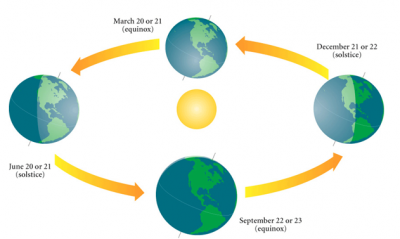The earth has two main motions:
(i) Rotation
(ii) Revolution.
Rotation:
The earth rotates around its axis. The axis is an imaginary line passing through the centre of the earth. The earth completes one rotation in 23 hours, 56 minutes, 4.09 seconds to be exact. The earth rotates from west to east. The period of rotation is known as the earthday.
Effects of the Rotation of the Earth:
- Causation of day and night
- This leads to the difference of 1 hour between two meridians which are 15°apart.
- Deflection of ocean currents and winds.
- Rise and fall of tides every day
Revolution:
It is earth’s motion in its elliptical orbit around the sun. One revolution is completed in 365 1/4 days, resulting in one extra day everyfourth year. The year, consisting of 366 days is called a “leap year” having 29 days in the month of February.
A year is usually divided into summer, winter, spring and autumn seasons. Seasons change due to the change in the position of the earth around the sun.
 On 21st June, the Northern Hemisphere is tilted towards the sun. The rays of the sun falldirectly on the Tropic of Cancer. As a result, these areas receive more heat. The areas near the poles receive less heat as the rays of the sun are slanting. There is longest day and shortest night in northern hemisphere on this day. While in Southern hemisphere completely opposite happened.This position of the earth is called the SummerSolstice.
On 21st June, the Northern Hemisphere is tilted towards the sun. The rays of the sun falldirectly on the Tropic of Cancer. As a result, these areas receive more heat. The areas near the poles receive less heat as the rays of the sun are slanting. There is longest day and shortest night in northern hemisphere on this day. While in Southern hemisphere completely opposite happened.This position of the earth is called the SummerSolstice.
On 22nd December, the Tropic of Capricorn receives direct rays of the sun as the South Pole tilts towards it. So, it is summer in the Southern Hemisphere with longer days and shorter nights. The reverse happens in the Northern Hemisphere. This position of the earth is called the Winter Solstice
On 21st March and September 23rd, direct rays of the sun fall on the equator. At this position, neither of the poles is tilted towards the sun; so, the whole earth experiences equal days and equal nights. This is called an equinox.
Earth Clouds are masses of minute water droplets and / or ice crystals formed by the condensation of water vapour and held in suspension in the atmosphere. Condensation, which results from cooling, usually takes place around nuclei such as dust, smoke particles and salt.





